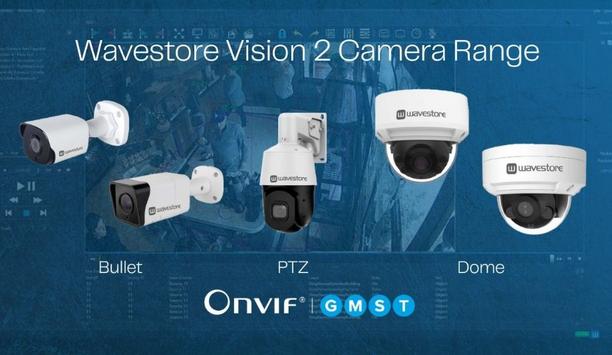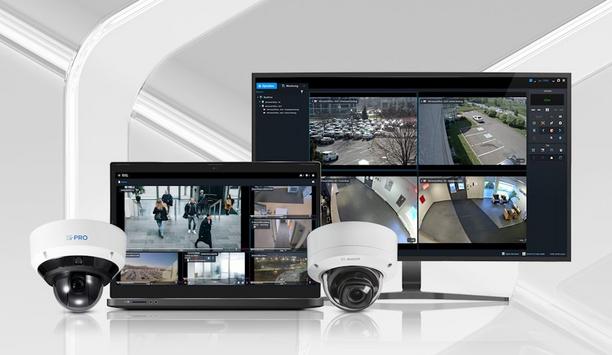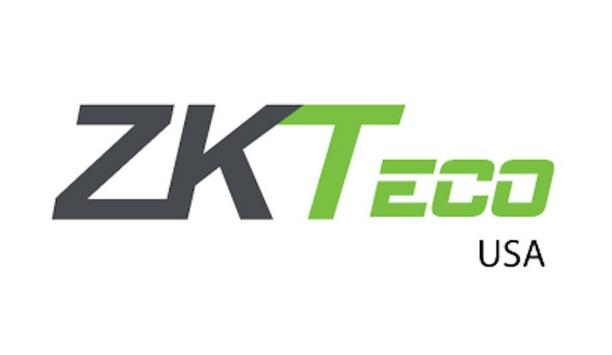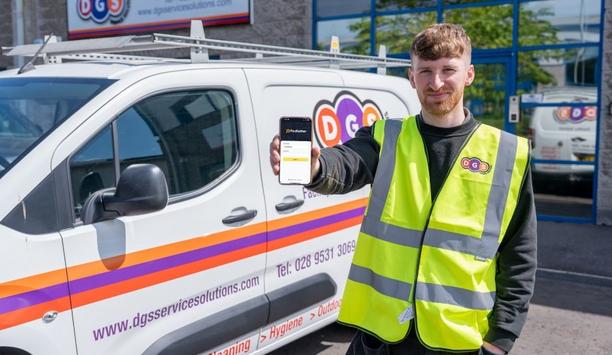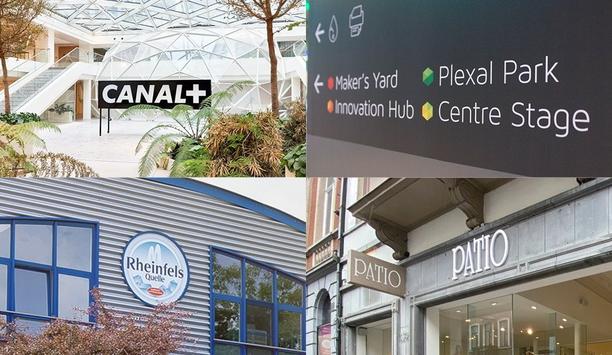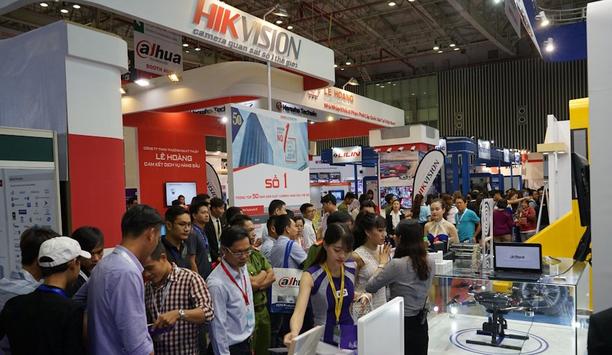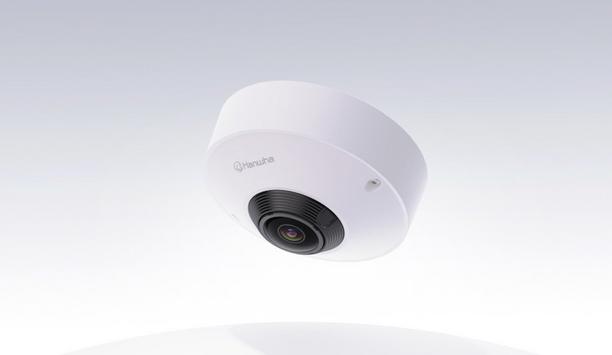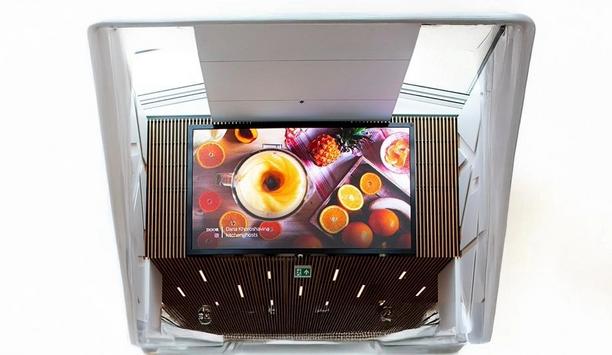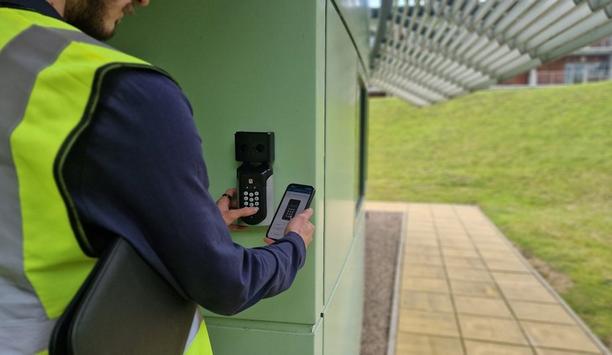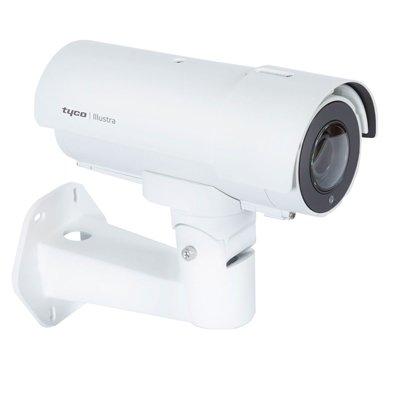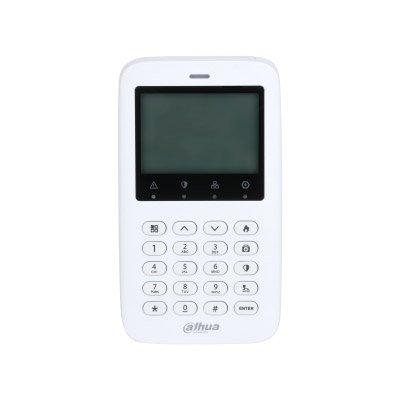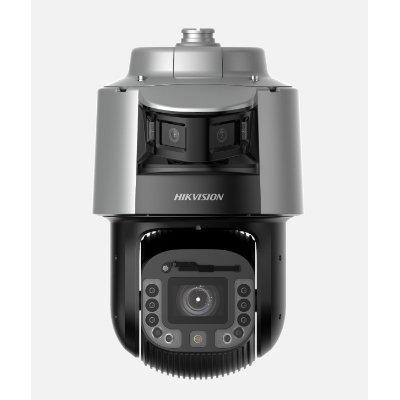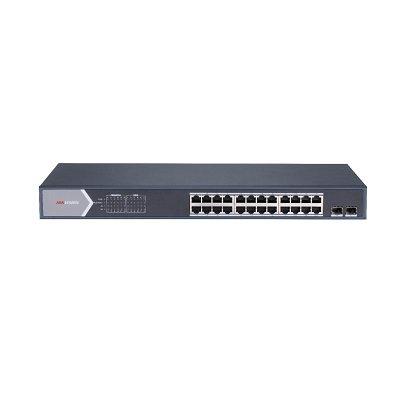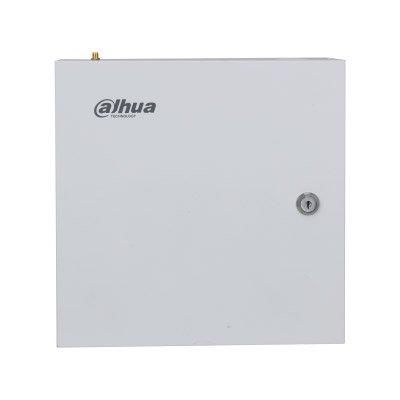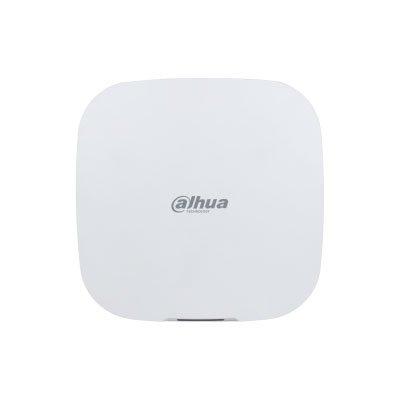Shop security systems
Wavestore announces the release of Wavestore v6.42, the latest iteration of its open-platform video management system (VMS), delivering deeper automation, enriched third-party integrations, and enhanced flexibility for modern security environments. Featuring automatic camera updates, an immediate Break Lock override, precision control via 3Dconnexion SpaceMouse, a new SDK for partners, expanded ONVIF compliance and virtual server support, plus specialized integrations with real-time weight meas...
Genetec Inc., the pioneer in enterprise physical security software, announced new updates to Security Center SaaS, the company’s enterprise-grade Security-as-a-Service (SaaS) solution. Since its launch, Genetec has delivered new features to the platform every 12 days. This ensures Genetec provides a flexible, open, SaaS solution that is continuously extended to meet the needs of any modern security operation. Third-party analytics integrations Latest updates expand support for direct-to...
Orange Business and Toshiba Europe have partnered to launch the first quantum-safe networking service in Paris, France. Orange Quantum Defender uses Toshiba’s Quantum Safe Networking technology, which combines Quantum Key Distribution (QKD) with Post Quantum Cryptography (PQC) for defense in depth. The service is now commercially available in the greater Paris area. The quantum-safe network The quantum-safe network offers the ultimate protection for sensitive data against future...
Artificial Intelligence Technology Solutions, Inc. (the “Company”), a global pioneer in AI-driven security and productivity solutions for enterprise clients, along with its wholly owned subsidiary Robotic Assistance Devices, Inc. (RAD), today announced the signing of a new national authorized dealer, marking a significant expansion into the logistics sector. The new dealer has placed an initial order for four RIO™ Mini solar-powered security trailers, each equipped with RAD&rs...
ZKTeco USA, a major provider of biometric verification and access control technology, announced the company has launched its new cloud-based access control software platform, Cielo365 that is changing the game in access control. Cielo365 is an add-on product that enables customers to easily transition from an on-premise solution to a cloud-based system effortlessly. The new software supports legacy ZKTeco devices and is compatible with existing access control hardware including SpeedFace and P...
DGS Service Solutions, an established provider of outsourced security, cleaning and facilities management services, has successfully implemented Podfather logistics software within its newly launched Industrial Division. With a focus on window cleaning, gutter cleaning, high level cleaning, power washing, and industrial deep cleans, Podfather provides DGS Industrial Services with a proven way to boost its customer experience. Addressing emerging market needs Using the Podfather app, operativ...
News
Six Degrees is pleased to announce the appointment of Mike Drolet as its new Chief Operating Officer (COO) and Tony Healy as its new Chief Information and Technology Officer (CITO). Both appointments bring an impressive track record to Six Degrees. As the Chief Operating Officer, Mike is focused heavily on the transformation and delivery of technology and services to the customers. Extensive experience With extensive global experience, he brings a wealth of knowledge in the deployment of innovative technology With extensive global experience, he brings a wealth of knowledge in the deployment of innovative technology and the delivery of strong, customer-centric results. Mike has held multiple COO positions within the technology, professional services, and consulting industries, and his tenure includes global roles with Geometric Results, Inc (GRI), Pontoon (a subsidiary of the Adecco Group), Infocrossing (a Wipro Company), and Deloitte. New CITO Tony is an award-winning Chief Information and Technology Officer with a proven track record of leading global technology functions across complex, fast-paced environments. He brings extensive experience from multiple private equity-backed organizations operating in pharma, transportation, retail, infrastructure, software, and professional services. Tony has delivered large-scale digital transformations, executed M&A integrations, and embedded cyber and data strategies that drive measurable business outcomes. He is known for shaping high-performing teams, modernising technology platforms, and aligning innovation with commercial growth. Drive new innovation Regarding his new role, Mike Drolet, COO, Six Degrees, said: “I’m delighted to be joining the Six Degrees team as Chief Operating Officer at such a pivotal time. I’m passionate about technology and delivering meaningful outcomes for our customers; I look forward to working with the extremely talented teams at Six Degrees to drive new innovation and deliver cutting-edge services and value to those we serve.” Ready to meet the future Tony Healy, CITO, Six Degrees, said: “I’m excited to join Six Degrees as Chief Information and Technology Officer. My focus will be on aligning our technology, cyber security, and product strategies with our broader business goals – delivering successful product launches, improving customer satisfaction, and ultimately driving organic growth.” “I’m particularly passionate about harnessing the potential of data and AI to drive innovation and value for Six Degrees and our customers, and I look forward to shaping agile, high-performing teams that are ready to meet the future head-on.” Authority comments Commenting on Mike and Tony’s appointments, Vince DeLuca, CEO, Six Degrees, said: “I’m really pleased to welcome Mike and Tony to Six Degrees. Their appointments will help us to achieve key strategic pillars including delivering for our customers now and in the future; reaching new markets; and elevating our service portfolio." "With their combined experience in transformation, innovation, and delivery, I believe we now have the right leadership team in place to realize our vision to be the most trusted and innovative managed services partner, empowering our clients’ success.”
Digitalization is high on the agenda, or well under-way, in all kinds of commercial environments. As part of this process, many businesses are discovering an additional ROI when they digitalize access management for offices, retail spaces, entertainment venues, warehouses and more. The challenges of securing these buildings are no secret. Staff and business security are a priority, including the resilience of operations and the maintenance of a company’s hard-earned reputation. Filtering access, however, should not erect barriers to accessibility. Buildings should be comfortable to use for all those who are authorized to enter them. Web management software Digital access makes this much easier to achieve, providing day-to-day benefits for each building stakeholder – employees and building managers, owners and the contractors who come and go through commercial building spaces every day. During use, when employees, contractors and visitors can come-and-go with ease, collaboration is simpler and administration for building managers is more streamlined. This functionality supports the broad contribution to business efficiency that digitalisation brings. This functionality supports the broad contribution to business efficiency that digitalisation brings There’s a device to lock almost any opening and a digital solution which can either extend existing access management capability or implement digital access from scratch without cabling or invasive installation. Mobile credentials stored on a smartphone can simplify and accelerate the process of issuing, amending and revoking access. Facility and security managers can benefit from web management software, including mobile access management, which enables remote monitoring and control from one convenient point, or even while off-site. Generating higher revenues According to digital transformation experts, digital access enhances operational agility, improves productivity, enhances security and encourages innovation. Deloitte research found evidence that businesses with greater ‘digital maturity’ generated higher revenues. “Access is an increasingly important part of a digital picture which incorporates both physical and cyber security measures,” says Joachim Mahlstedt, Director and CCO Digital Access Solutions at ASSA ABLOY Opening Solutions EMEIA. “Digitalising access quickly provides benefits which a business can turn into a competitive advantage. It puts powerful tools in the hands of a commercial building manager, as these four real projects demonstrated.” Multiple building technologies Example 1 – Office building Managing access manually and updating multiple systems in parallel can eat up a large amount of facilities staff time. There is a more efficient alternative: management of offices is more streamlined and errors are minimised when multiple building technologies, including access, are connected. There is a more efficient alternative: management of offices is more streamlined and errors are minimised At a new corporate headquarters for Canal+ near Paris, for example, various devices from ASSA ABLOY’s suite of connected Digital Access Solutions – including battery-powered Aperio® wireless handles with integrated readers and ABLOY electromechanical security locks – integrate with a Genetec system to filter access to and through all technical areas, for 1,200 employees plus visitors and contractors. This native integration adds control without adding management complexity. Aperio is not an ‘add-on’, no extra database is required. It becomes part of one streamlined system, controlled from a single interface. Programmable key-operated digital access Example 2 – Manufacturing site Digital access is also available for high security environments and/or locations where multiple different cylinder types must be used. In Germany, RheinfelsQuellen opted for ASSA ABLOY’s eCLIQ programmable key-operated digital access. At its Duisburg HQ and other locations around North Rhine–Westphalia, their new digital locking operates reliably both indoors and outside. The system is managed via the CLIQ Web Manager (CWM); system data may be accessed at any time, and from any location, via the CWM interface. The software's flexibility makes it especially suited to large access systems or for multiple locations which are geographically dispersed. “We would choose this secure and flexible locking solution time and time again,” says Marcus Schlötels, Project Manager at RheinfelsQuellen. Software-powered digital access solution Example 3 – Small retail ASSA ABLOY’s Code Handle locks fitted on a few key doors were the answer Petty theft from stockrooms and shop floors is a persistent problem for retailers. Yet in small premises, a software-powered digital access solution may not be appropriate. In Leuven, Belgium, upscale fashion boutique Patio sought an easy, low-cost deterrent. ASSA ABLOY’s Code Handle locks fitted on a few key doors were the answer. Door security is operated by a discreet PINpad built into a brushed-chrome handle. Two standard batteries slot inside each Code Handle to power the digital security. These typically last for 30,000 lock/unlock cycles. Code Handle comes with one Master PIN; the store manager issues up to 9 additional 4–6-digit PINs. When an employee leaves Patio, it’s simple to delete their PIN. Flexible work environment Example 4 – Flexible workspace Modern workplace design needs access control that is powerful, flexible and aesthetically in tune with building users. At Plexal, an East London flexible work environment used by up to 800 entrepreneurs, ASSA ABLOY Aperio digital access achieves all three. Plexal offices are fitted with Aperio wireless digital locks which are integrated with DoorFlow, NetNodes’ online platform for managing and auditing access. These locks provide Plexal with physical security and transmit door status to DoorFlow in real time. Because they are battery- rather than mains-powered, Aperio locks also keep maintenance costs and energy consumption low. “Digitalisation presents huge challenges and opportunities for businesses of every size and type, in access management and beyond,” adds Joachim Mahlstedt. “Our expertise in access, established over decades, enables us to work with customers to truly get their access ready for what’s ahead. With ASSA ABLOY, they digitalise with confidence.”
Against the backdrop of Vietnam’s expanding security, fire safety, and smart building sectors, Secutech Vietnam will return to the Saigon Exhibition and Convention Center (SECC) in Ho Chi Minh City from 14 – 16 August 2025. The 18th edition will span 13,000 sqm, hosting 480 exhibiting brands, presenting the latest solutions driving safer cities and smarter infrastructure. Held with concurrent events Fire & Safety Vietnam and SMABuilding, Secutech Vietnam will spotlight technologies advancing safety, efficiency, and resilience across the country’s urban and industrial sectors. Increasing Demand Driving this demand is a 7.3% year-on-year increase in Foreign Direct Investment (FDI) in Vietnam Driving this demand is a 7.3% year-on-year increase in Foreign Direct Investment (FDI) in Vietnam, reaching over USD 6.7 billion in the first four months of 2025. This influx creates significant opportunities for companies offering security systems, fire protection equipment, and smart building technologies. In addition, the country’s rapid infrastructure development, and its construction sector’s integration of advanced security solutions, further heightens the need for enhanced security measures. Secutech Vietnam provides a targeted networking environment, connecting exhibitors directly with investors, developers, and project managers seeking innovative solutions. Factors driving market growth Ms Regina Tsai, General Manager of Messe Frankfurt (HK) Ltd – Taiwan Branch, elaborated on the factors driving market growth: “The demand for safety and security in Vietnam is on the rise, fueled by market expansion, urbanisation, and government initiatives such as smart city investments and stricter safety regulations.” “These efforts are bolstering urban resilience and creating a significant need for advanced solutions. Testament to the market’s potential, the healthy showing of exhibitors at Secutech Vietnam 2025 are featuring a wide array of technologies, from surveillance cameras, to synergy voice alarm systems, to advanced fire suppression systems.” “This platform serves as a catalyst for international suppliers to connect with Vietnamese businesses eager to enhance their capabilities.” More to showcase at the fair In addition to traditional security systems, the fair will showcase AI-powered surveillance tools, IoT-enabled devices, ICT infrastructure, and technologies for smart city development, industrial automation, and smart building management. Other featured technologies include cybersecurity, access control, smart home automation, and advanced fire prevention systems. Featured pavilions and new zones spotlight industry development Providing suppliers with opportunities to connect with local distributors, integrators, and other market players, the fair’s numerous pavilions and zones reflect global interest in Vietnam’s growing security market. The platform will feature prominent international pavilions from Korea, Japan, and Singapore, as well as the MIT (Made-in-Taiwan) Innovation Pavilion. Complementing these, the fair will introduce dedicated solution zones focused on AI Video Analytics and Facility Access Control – areas experiencing rapid demand driven by the need to safeguard critical infrastructure and optimize operational efficiency. AI Video Analytics: featuring intelligent video surveillance solutions with automated threat detection and real-time alerts to improve situational awareness and response efficiency. Facility Access Control: presenting advanced visitor management systems that secure industrial and critical infrastructure by regulating entry and monitoring personnel movement. Fire safety will also take a prominent role, with two dedicated areas: the Occupational Safety and PPE Zone and the Disaster Prevention Zone, emphasising Vietnam’s commitment to safety in both industrial and urban settings. New fire safety law fuels growth for concurrent shows Vietnam is prioritising fire safety, as demonstrated by the 2024 Law on Fire Prevention, Fighting, and Rescue, mandating stricter requirements for mixed-use buildings and driving investments in the most advanced systems. Set to take effect this July, this law will create significant opportunities for exhibitors at Fire & Safety Vietnam, supported by the Fire and Rescue Police Department, and SMABuilding, both held concurrently with Secutech Vietnam. Conclusion The convergence of these shows allows visitors to efficiently source a wider range of products and services, from fire detection and suppression to integrated security and smart building technologies, all under one roof. The platform addresses the interconnected needs of Vietnam's security, fire safety, and smart building sectors, bringing the market’s newest inventions directly to industry professionals and decision-makers.
Assist Security Group (ASG) has announced the appointment of Jim McFedries as Chief Business Development Officer. In this strategic role, McFedries will drive business growth and expand ASG's client portfolio across key sectors including retail, healthcare, and property management. McFedries brings over three decades of security industry expertise to ASG, with significant experience in both corporate security leadership and commercial security services. His appointment reinforces ASG's commitment to delivering innovative, client-focused security solutions. Jim's track record "We're delighted to welcome Jim to the ASG leadership team," said Troy Hewitt, CEO of ASG. "His extensive experience in both corporate security and commercial security services gives him a unique perspective on client needs." "Jim's proven track record in developing strong client relationships and his deep industry knowledge will be invaluable as we continue to grow." ASG's industry profile McFedries will focus on raising ASG's drive profile, growing the firm's product and service offerings In his new role, McFedries will focus on raising ASG's industry profile, developing the company's product and service offerings, and expanding its client base with a collaborative approach focused on delivering cost-effective, risk-based security that creates genuine value for clients. Before joining ASG, McFedries served for five years at Argenbright Security Europe Limited (ASEL), where he held several leadership positions, including Group Operations Director, before taking on the role of Sales and Accounts Director. Regional security and loss prevention roles McFedries also brings substantial retail security expertise, having spent 11 years as Head of Profit Protection & Security at Scotmid Co-operative, where he was responsible for the organization's security and loss prevention strategy. His earlier career included various regional security and loss prevention roles within the retail sector. "I'm excited to join ASG at such a key time in the company's development," said McFedries. "The business has great potential, with exceptional people and a solid reputation for quality service delivery. I look forward to building on these foundations by highlighting our expertise and developing solutions that address our clients' evolving needs."
Hanwha Vision, the global vision solution provider, has launched Q series fisheye cameras with enhanced AI, providing a range of intelligent analytics alongside 360-degree monitoring. Ideally suited for retail, hospitality, public spaces, and residential settings, with models QNF-C9010 for indoor use, and QNF-C9010V for outdoor use. Efficient investigations with AI Accurate object detection and classification, powered by leading AI algorithms, reduces false alarms caused by wildlife, weather, and changing light patterns. The cameras generate object metadata for quick forensic search in complex scenes, making investigations highly efficient. Footage can be searched based on detected vehicles, people - plus color of clothing (upper and lower) and vehicle color. Nine colours can be detected, including black, white, gray, and primary colours. The cameras feature a host of intelligent video analytics including virtual area, appear and disappear, and line-crossing detection. Alerts can be issued based on predefined rules, such as a person remaining in a space for a specific time, or a vehicle crossing a virtual line into a car park. Business intelligence for data-driven decisions The fisheye cameras include heatmapping analytics, people and vehicle counting, and queue management, to enable more strategic decisions such as staffing for checkout counters in a retail space, where to place advertising in public spaces, or limiting the number of people entering a hospitality venue. This delivers value beyond security in other business areas such as marketing, sales, and operations. Clear images, compact form To deliver clear images to operators, the cameras have on-board dewarping To deliver clear images to operators, the cameras have on-board dewarping, which stretches footage out to a horizontal, wide field of view, with no distortion of the image at the edges. There are options for single four-frame views of a space, double or single panoramas, and quad views. The QNF-C9010 is a compact fisheye camera, 52mm in height, making it ideal for indoor settings where it can be discreetly installed on a ceiling or wall. The QNF-C9010V is a larger model with an aluminum casing and IP66 and IK10 ratings, and vandal protection, designed for outdoor environments. Next-level cybersecurity The Q series AI fisheye cameras come with industry-leading end-to-end cybersecurity features, including user and network authentication, secure communication, access control based on IP addresses, device ID, and secure storage. Footage and data are securely stored, with hacking risk pre-empted through unauthorized access blocking. John Lutz Boorman, Head of Product and Marketing, Hanwha Vision Europe, said, “The latest Q series fisheye cameras deliver the benefits of our leading AI-powered analytics to help operators and businesses make smarter decisions. With 360-degree monitoring, a compact and discreet form factor, and business intelligence capabilities, these cameras suit a multitude of applications.”
Keysight’s Riscure Security Solutions has been accredited by the European Payments Initiative (EPI) to conduct security evaluations for Payment Service Providers (PSPs), including both acceptor and consumer evaluations. The device security research lab’s accreditation marks an expansion of Keysight’s EPI certification services, which enable a review of the full range of EPI certification and approval objects, including: EPI Standalone Wallet EPI Digital Wallet Applications embedded in the Payment Service Provider’s (PSP) own Wallet EPI PSP Evaluations (acceptor and consumer) Security requirements “With this accreditation, we’re able to support even more companies in securing their payment solutions,” said Pascal van Gimst, VP of Sales and Business Development at Keysight. “We continue to help our clients navigate security requirements confidently, so that they can focus on building great products and delivering the best experience to their customers.” What is EPI? The goal of the EPI is to develop a comprehensive digital wallet based on the instant payment scheme The EPI is an initiative formed by 16 European banks and financial service providers to build a new digital wallet and a unified account-to-account solution for Europe. The solution aims to establish a new standard in payment methods across Europe, benefiting consumers and merchants across all retail transactions, whether in-store, online, or person-to-person (P2P). The goal of the EPI is to develop a comprehensive digital wallet based on the instant payment scheme, as defined by the European Payments Council (EPC). Digital wallets support various transactions between merchants and individuals, and aim to provide robust security and immediacy through a user-friendly interface. The EPI initiative aligns with Europe’s move towards instant payments and is a response to calls from European authorities for the development of an independent, alternative payment system based on instant payment schemes. Keysight helps customers navigate security requirements Keysight’s expertise in payment security enables vendors to efficiently navigate certification and strengthen the security of their payment solutions. This enables vendors to demonstrate compliance with strict security requirements covering cryptographic protection, secure authentication, and transaction integrity.


Expert commentary
The physical security industry has been in love with the cloud for quite some time. And understandably so. The promise of instant scalability, centralized access, and simplified maintenance is hard to ignore, especially in an era of remote work and distributed facilities. But reality is catching up to the hype. For many, especially those dealing with video surveillance at scale, the cloud is no longer the catch-all solution it once seemed. Rising costs, bandwidth limitations, and latency issues are exposing its shortcomings. And the more resolution increases, from HD to 4K and beyond, the heavier that burden becomes. Modern security cameras This is where edge computing, specifically AI-enabled edge processing available in modern security cameras, starts to look less like an option and more like a necessity. But it’s not just about adding intelligence to cameras. It’s about how that intelligence is deployed, scaled, and maintained. This leads us to containerization and tools such as Docker, which are a revolutionary piece of the puzzle. When cloud isn't enough Cloud analytics for video sounds great in theory: stream everything to the cloud Let’s start with a basic issue. Cloud analytics for video sounds great in theory: stream everything to the cloud, let powerful servers do the thinking, then serve up results to end-users in real time. However, in practice, this model can break down quickly for many end-users. Raw video is heavy. A single 4K camera streaming 24/7 can generate terabytes of data per month. Multiply that by hundreds or thousands of cameras, and the bandwidth and storage costs become unsustainable. Then there’s latency. If AI needs to detect a person entering a restricted area or identify a license plate in motion, seconds count. Routing video to a cloud server for analysis and waiting for a response can introduce delays. Adding in concerns about uptime, such as what happens if the internet connection goes down, it becomes clear why relying exclusively on the cloud creates friction for mission-critical deployments. The edge advantage Edge processing turns that model on its head. Instead of sending everything out for analysis, edge-enabled cameras do the heavy lifting on-site. AI algorithms run directly on the device, interpreting what they see in real time. They generate metadata—lightweight descriptions of events, objects, or behaviors—rather than raw video. This metadata can be used to trigger alerts, inform decisions, or guide further review. The benefits are obvious: latency drops, bandwidth use plummets, and storage becomes more efficient. Edge processing solves many cloud deployment issues by keeping the compute where the data is generated, on the device. This frees the cloud up to do what it’s best at: providing scalable and centralized access to important footage. But where does the edge go from here? How do we evolve these powerful IoT devices to deliver even more situational awareness? Enter Docker: An app store for edge AI They package an app along with everything it needs to run: the code, settings, libraries, and tools This is where the concept of containerization and open development platforms like Docker comes in. Let’s start with an analogy that is helpful for understanding containers. Imagine you're getting ready for a trip. Rather than hoping your hotel has everything you need, you pack a suitcase with all your essentials: clothes, toiletries, chargers, maybe even snacks. When you arrive at your destination, you open the suitcase and you’re ready to go. You don’t need to borrow anything or adjust to whatever the hotel has, since you’ve brought your own reliable setup. Containers in software work the same way. They package an app along with everything it needs to run: the code, settings, libraries, and tools. This means the application behaves exactly the same, whether it’s running on a developer’s laptop, on the edge in an IoT device, or in the cloud. Security camera with a powerful edge processor There’s no last-minute scrambling to make it compatible with the environment it lands in, because it’s self-contained, portable, and consistent. Just like a well-packed suitcase simplifies travel, containers simplify software deployment. They make applications faster to start, easier to manage, and more predictable, no matter where they’re used. For a security camera with a powerful edge processor, it’s like giving the camera its own specialized toolkit that can be swapped out or upgraded without touching the rest of the system. It also means you can run multiple AI applications on a single camera, each in its own isolated environment. Integrators and end-users These applications don’t interfere with each other and can be updated independently Want to add fall detection to a healthcare facility’s camera network? Just deploy the analytics in a container. Need to monitor loading docks for pallet counts at a warehouse? Spin up a different container. These applications don’t interfere with each other and can be updated independently. As a developer, if you use an open container platform like Docker, any system that supports Docker can utilize your software. This removes the need to do expensive custom work for each partner and ecosystem. This is one reason Docker containers are tried and true in the larger IT space and are just starting to get traction in the security sector. Docker also makes this scalable. Developers can build AI tools once and push them out to hundreds or thousands of devices. Integrators and end-users can customize deployments without being locked into proprietary ecosystems. And because containers isolate applications from core system functions, security risks are minimized. Metadata, not megabytes Traditional video analytics systems often require full video streams to be processed One of the most underappreciated aspects of this method is the way it redefines data flow. Traditional video analytics systems often require full video streams to be processed in centralized servers, either on-premises or in the cloud. This model is brittle and costly, and it’s also unnecessary. Most of the time, users aren’t interested in every frame. They’re looking for specific events. Edge AI enables cameras to generate metadata about what they see: “Vehicle detected at 4:02 PM,” “Person loitering at entrance,” “Package removed from shelf.” This metadata can be transmitted instantly with minimal bandwidth. Video can still be recorded locally or in the cloud, but only accessed when needed. This dramatically reduces network load and allows the cloud to be used more strategically: for remote access, long-term archiving, or large-scale data aggregation, without being overwhelmed by volume. Building smarter systems, together A single camera can run analytics from multiple third parties, all within a secure, containerized framework An equally important aspect of containerization is how it opens up the ecosystem. Traditional security systems are often built as closed solutions. Everything—from the cameras to the software to the analytics—comes from a single vendor. While this simplifies procurement, it limits innovation and flexibility. Docker flips that model. Because it’s an open, well-established standard, developers from any background can create applications for edge devices. Integrators can mix and match tools to meet unique customer needs. A single camera can run analytics from multiple third parties, all within a secure, containerized framework. This is a profound shift. Security cameras stop being fixed-function appliances and become software-defined platforms. And like any good platform, their value increases with the range of tools available. Hybrid: The realistic future So, where does this leave the cloud? It is still essential, but in a more specialized role. The most robust, future-proof architectures will be hybrid: edge-first and cloud-supported. Real-time detection and decision-making happen locally, where speed and uptime matter most. The cloud handles oversight, coordination, and data warehousing. Real-time detection and decision-making happen locally, where speed and uptime matter most This hybrid model is especially useful for organizations with complex deployments. A manufacturing plant might retain video locally for 30 days but push older footage to the cloud to meet retention requirements. A retail chain might analyze customer flow on-site but aggregate trend data in the cloud for HQ-level insight. Hybrid gives organizations the flexibility to optimize cost, compliance, and performance. Regulatory realities It’s also worth noting that not every organization can, or should, store data in the cloud. Privacy regulations like GDPR in Europe or similar laws elsewhere require strict control over where data is stored. In many cases, sensitive footage must remain in-country. Edge and hybrid models can make compliance easier by minimizing unnecessary data movement. Conclusion: Smart security starts at the edge The next wave of innovation in physical security won’t come from bigger cloud servers or faster internet connections. It will come from smarter edge devices, with cameras and sensors that don’t just record, but understand and classify events. And the foundation for that intelligence isn’t just AI, but how that AI is deployed. Containerization via platforms like Docker is unlocking new levels of flexibility, security, and scalability for the physical security industry. By embracing open standards, supporting modular applications, and rethinking how data flows through the system, physical security professionals can build solutions that are not only more effective but also more sustainable, secure, and adaptable. The cloud still has its place. But the edge is essential to the future for real-time intelligence, mission-critical uptime, and cost-effective deployment.
Retailers now often find themself in a precarious situation. Profit margins are being squeezed by widespread shoplifting: The Council on Criminal Justice reports that between the first half of 2023 and the first half of 2024, shoplifting reports increased by 24%. Meanwhile, the strategies used by shops to deal with this situation are alienating consumers and affecting total sales. Andy Jassy, the CEO of Amazon, stated during an earnings call that customers are now purchasing more pharmaceuticals from Amazon in response to other retailers locking their cabinets. Media reports This crisis impacts not only the large chains—more than 7,100 retail stores were closed in the U.S. in 2024, a 69% increase from the previous year—but also small, local businesses, whose profit margins are even narrower. Media reports out of Los Angeles show that small businesses in regions with greater shoplifting rates are more likely to close, and small business owners' job satisfaction and general well-being are negatively impacted by the fear of crime. How to safeguard staff and inventory Unchecked retail theft demoralizes staff and makes the store less attractive to customers This is obviously not a sustainable situation. In addition to lowering revenue, unchecked retail theft demoralizes staff and makes the store less attractive to customers. Unfortunately, making customers wait in line to enter a store or locking up toothpaste and deodorant only makes the customer relationship worse. Retailers need to figure out how to safeguard staff and inventory without alienating their customer base—and they need to figure it out fast. Advanced video security A new tool has come to the forefront of this fight: advanced video security. Of course, video surveillance has been used in stores for many years. However, the technology currently being used to reduce retail theft is very different from the outdated analog video systems of the past. With features like cloud-based flexibility and AI-enhanced analytics, this new generation of video surveillance systems has all the advantages of modern technological advancements, while also providing businesses with a competitive edge in the fight against retail theft. Security's new AI video standard Workers are constantly rushing from aisle to aisle in an effort to satisfy eager consumers Although the typical chain pharmacy may appear straightforward to the customer, retailers are aware of how intricate these spaces are. Hundreds or even thousands of shoppers may come and go on any given day, with a larger volume during busy seasons like holidays or special promotional events. It's common for shoppers to pick up merchandise and put it down in another part of the store, often far away from its original location. Meanwhile, workers are constantly rushing from aisle to aisle in an effort to satisfy eager consumers, particularly during these busy seasons. How much can recorded videos reveal in a busy Using traditional CCTV, managers and security teams can monitor some of this activity, but their viewpoint of events will always be incomplete. There is a limit to how much recorded videos can reveal in busy, fast-paced customer situations, and even the largest chain stores lack the staff and resources to continuously sort and evaluate all of the data they collect. When more customers are in the store for a special event, there’s also naturally a higher risk of theft. New generation of video security Using machine learning algorithms trained on large amounts of retail-specific data The new generation of video security aims to provide retailers with comprehensive intelligence that covers all aspects of their operations. Using machine learning algorithms trained on large amounts of retail-specific data, they are focused on predictive actions and can recognize problematic behavior in real time from raw video footage. AI-powered surveillance For example, if someone entered a store with empty bags but bypassed the cashier and started heading to the exit with a full bag, AI could predict a potential theft before it happens. Instead of just recording the theft, security action could be triggered in the moment. AI-powered surveillance is like an all-seeing security officer, quickly analyzing the thousands of variables at play and spotting the warning signs of a possible crime before it happens. This is especially crucial during the holidays and busy shopping periods. Security personnel required to monitor cameras Imagine a chain store with 500 locations and 32 cameras each: that’s 1,600 cameras Cameras with AI can also alert human security personnel of events that would have otherwise been missed. Imagine a chain store with 500 locations and 32 cameras each: that’s 1,600 cameras. Now just imagine the number of security personnel required to monitor all of those cameras – when it comes down to it, traditional security is a numbers game. AI is the differentiator here that will allow retailers to win this game. VSaaS: A new tool to Deter Theft The emergence of Video Surveillance as a Service (VSaaS), a surprisingly under-discussed aspect of the broader SaaS revolution, is an important part of video security’s evolution. VSaaS solutions are especially helpful for chains that require a high level of centralization and coordination across hundreds or even thousands of locations. In addition to offering action alerts at the shop level, VSaaS offers comprehensive security systems accessible from any location. This gives corporate headquarters access to complete, aggregated insights on all aspects of business operations. Identify the best ways to deploy staff Retail operators are constantly in a state of triage, rushing to identify the best ways to deploy staff This is significant in part because of the importance that social engineering and store layout have in preventing theft. Stores are frequently more busy during specific hours than others, and consumers may congregate in particular areas of the store while others are comparatively empty. Retail operators are constantly in a state of triage, rushing to identify the best ways to deploy staff and organize inventory while accounting for all of these variables. Cloud-based VSaaS solutions Cloud-based VSaaS solutions help streamline this process by eliminating uncertainty, highlighting blind spots and bottlenecks, and informing retailers of what truly works. Another regrettable reality is that employees frequently steal from businesses they work at. Here, too, VSaaS solutions—when combined with sophisticated, integrated access controls—are essential. AI analytics technology Implementation and deployment of VSaaS is also easier and less costly than CCTV Implementation and deployment of VSaaS is also easier and less costly than CCTV. When new AI analytic updates become available, the client software and hardware don’t need to be upgraded, and the onsite technology and cameras also don’t need to be replaced. The AI analytics technology is upgraded in the cloud, enabling faster deployment and implementation of new technology. New VSaaS solutions Theft will always occur at some level; it's just a part of doing business. However, the growth in shoplifting that retailers have experienced in recent years is unacceptable, and if these figures keep rising, the consequences will be disastrous. In a time of dire need for retail, new VSaaS solutions have come to the forefront and are already turning the tide.
For businesses today, loss prevention is no longer just about safeguarding inventory from theft. While retail theft makes frequent headlines in the United States, and is indeed the leading cause of shrinkage, The National Retail Foundation (NRF) has reported that process failures, operational inefficiencies and employee theft also drive significant losses. Legacy security systems In 2022, the shrink loss is estimated to be $120billion in the United States, and that’s for retail alone. Industries like hospitality, healthcare, manufacturing, and transportation all face similar challenges even though loss and inefficiency take different forms in each of these fields. As shrinks from theft and operational inefficiency have already put margins of companies under pressure, we are increasingly seeing more businesses demand AI-powered security systems with advanced video analytics, capable of addressing both security and operational inefficiencies that their legacy security systems could not. Understanding the full scope of loss Package theft is a common problem in commercial buildings, with which box detection in mailrooms Starbucks’ recent announcement of reinventing its franchise operation due to faltering sales is a great example of how operational efficiency can take a toll on business revenue. In restaurants or hotels, failing to anticipate customer flow can lead to long wait times or inefficient use of staff, frustrating guests. Take, for example, in hospitals, inefficient patient flow management can lead to overcrowded waiting areas and delays in care, compromising patient health. Similarly, in manufacturing, poorly optimized assembly lines create production bottlenecks, delaying output and raising overhead. Package theft is another common problem in commercial buildings, with which package detection in mailrooms can mitigate loss from deliveries. These invisible leaks creepingly drain profits across industries, and require future-proof solutions that not only confirm what’s already known but also provide actionable insights for improvement. Transforming security into a powerhouse for efficiency Progress continues to advance across these areas, fueling optimism for what lies ahead. Thanks to the rise of artificial intelligence and data analytics, some security solutions are already integrated with facial recognition and license plate detection capabilities, as well as Virtual Fences that help ensure that only authorized personnel or vehicles enter sensitive areas. This can be especially useful for manufacturing environments, where controlling access to high-risk zones and protecting valuable assets are critical. Some modern security systems can even offer more than a watchful eye, doubling as a data analytic tool beyond traditional surveillance limits. Heat mapping in security AI technology Heat mapping in security AI technology analyzes ways of movement and behavior in a retail environment Modern security systems are now capable of tracking foot traffic, analyzing customer behavior, and even identifying bottlenecks in real time by incorporating different technologies such as heatmapping, people counting and queue length monitoring for long lineups. Heat mapping in security AI technology analyzes patterns of movement and behavior in a retail environment by visually representing areas with high foot traffic. With tracking over time and identifying potential vulnerable and hot spots for potential theft and fraud, resulting in change of store layout, deploy additional resources in high traffic areas and physical security placement. Predictive security analytics AI people counting in security utilizes sensors and cameras to accurately track the number of individuals entering and exiting a space in real time. This data helps businesses optimize staffing levels, enhance customer experience, and improve overall operational efficiency by aligning resources with foot traffic trends. Predictive security analytics, such as heat mapping and people counting, are not new inventions. But I believe the ability to integrate all these functionality into a single system will allow these technologies to further mature and expand their footprint in near future. Rather than relying on separate tools for each business function, businesses can now use a single, integrated system to gather actionable data while continuing to secure protection through video surveillance. You Can’t Manage What You Can’t Measure AI-powered security systems give businesses access to a wealth of data that they can use AI-powered security systems give businesses access to a wealth of data that they can use to precisely pinpoint where losses are happening. This is key to solving the problem of shrinkage, which often goes beyond simple theft. Consider the Starbucks case mentioned earlier, while Starbucks hasn't specified how it plans to achieve operational efficiency to “enhance the cafe experience”, an AI-powered security system could provide an all-encompassing solution to minimize bottlenecks during peak hours, optimize store layouts, and allocate staff more efficiently. The impact of this technology can be tremendous as it not only enhances the customer experience but also reduces inefficiencies that contribute to lost revenue. By analyzing patterns, conducting Forensic Review with Smart Search to quickly locate incidents, and understanding the root causes of loss, companies can implement targeted solutions that reduce shrinkage and streamline operations. Future-proof solutions Walmart is using foot traffic analytics to predict demand and manage inventory Companies like Walmart are already using foot traffic analytics to predict demand and manage inventory. But beyond basic predictive inventory analysis and crowd control, the data gathered will have the potential to be combined with other business functions, smart energy management, pricing and marketing strategy, just to name a few. Investing in a security system that integrates AI video analytics, such as package detection, queue length monitoring, and Virtual Fences, can provide future-proof solutions that also enhance operational efficiency. Looking ahead With New York State's introduction of new Retail Security measures to encourage businesses to strengthen their security, we've seen increased interest. However, modern security systems with real-time analytics are now offering companies more than just protection—they’re providing valuable insights into operations, transforming security from a cost burden into a powerful tool for growth and efficiency. As businesses continue to adopt AI-powered security systems, it's clear that the role of security is evolving beyond traditional surveillance. These advanced systems are no longer just about protection, but help businesses grapple with increasingly complex challenges. By transforming security from a reactive expense into a proactive, data-driven asset, companies can stay ahead of the curve, managing not only what they can see, but also what they’ve been missing.
Security beat
Anyone who has been in a proverbial cave for the last couple of years faced a language barrier at this year’s ISC West 2025 trade show. The industry’s latest wave of innovation has brought with it a new bounty of jargon and buzzwords, some of which I heard at ISC West for the first time. As a public service, we are happy to provide the following partial glossary to promote better understanding of the newer terms. (Some are new to the security industry but have been around in the IT world for years.) Obviously, if we can’t understand the meaning of the industry’s lexicon (and agree on the meaning of terms!), we will struggle to embrace the full benefits of the latest industry innovation. Not to mention we will struggle to communicate. Generative AI Generative AI can identify an object in an image based on its understanding of previous objects This was perhaps the most common new(ish) term I heard bouncing around at ISC West. While the term artificial intelligence (AI) now rolls off everyone’s tongue, the generative “version” of the term is catching up. Generative AI uses what it has learned to create something new. The name comes from the core function of this type of artificial intelligence: it can generate (or create) new content. It doesn’t just copy and paste; it understands the underlying patterns and creates something original based on that understanding. In the case of video, for example, generative AI can identify an object in an image based on its understanding of previous objects it has seen. Video and security Generative AI can tell you something digitally about what is happening in an environment. There is no longer a need to write “rules;” the system can take in data, contextualize it, and understand it, even if it does not exactly match something it has seen before. In the case of video and security, generative AI offers more flexibility and better understanding. From 2014 to 2024, the emphasis was on detecting and classifying things; today AI is expanding to allow new ways to handle data, not so prescriptive and no more rules engines. Agentic AI Agentic AI refers to artificial intelligence systems that can operate autonomously to achieve specific goals Agentic AI refers to artificial intelligence systems that can operate autonomously to achieve specific goals, with minimal to no direct human intervention. In addition to the capabilities of generative AI, agentic AI can take action based on what it detects and understands. Use of agentic AI typically revolves around an if/then scenario. That is, if action A occurs, then the system should proceed with action B. For example, if an AI system “sees” a fire, then it will shut down that part of the building automatically without a human having to initiate the shutdown. There is a lot of discussion in the industry about the need to keep humans involved in the decision-making loop, so use of truly autonomous systems will likely be limited in the foreseeable future. However, the ability of agentic AI to act on critical information in a timely manner, in effect to serve as an “agent” in place of a human decision-maker, will find its place in physical security as we move forward. Inference Inference is another common term related to AI. It refers to the process by which an AI model uses the knowledge it gained during its training phase to make predictions, classifications, or generate outputs on new, unseen data. The direct relationship of this term to physical security and video is obvious. In the simplest terms, an AI system is “trained” by learning patterns, relationships, and features from a large dataset. During inference, the trained model is presented with new questions (data it hasn't seen before), and it applies what it learned during training to provide answers or make decisions. Simply put, inference is what makes AI systems intelligent. Containerization Dividing a massive security management system into several separate containers enables management of the various parts In IT, containerization is a form of operating system-level virtualization that allows you to package an application and all its dependencies (libraries, binaries, configuration files) into a single, portable image called a container. This container can then be run consistently across any infrastructure that supports containerization, such as a developer's laptop, a testing environment, or a server in the cloud. In the physical security industry, you hear “containerization” used in the context of separating out the various components of a larger system. Dividing a massive security management system into several independent containers enables the various parts to be managed, updated, and enhanced without impacting the larger whole. Genetec’s SecurityCenter cloud platform Think of it like shipping containers in the real world. Each container holds everything an application needs to run, isolated from other applications and from the underlying system. This ensures that the application will work the same way regardless of the environment it is deployed in. “It took us five years to containerize Genetec’s SecurityCenter cloud platform, but containerization now simplifies delivering updates to products whenever we want,” says Andrew Elvish, Genetec’s VP Marketing. Among other benefits, containerization enables Genetec to provide more frequent updates--every 12 days. Headless appliance Headless appliance is a device that is managed and controlled remotely through a network or web interface A headless appliance is a device that is managed and controlled remotely through a network or web interface. The device is like a “body without a head” in the traditional sense of computer interaction: It performs its intended function, but without any visual output or input device for local interaction. In physical security, such devices are increasingly part of cloud-based systems in which the centralized software manages and operates all the disparate “headless” devices. A headless appliance does not have a Windows management system. “The whole thing is managed through the as-a-service cloud system,” says Elvish. With a headless device, you just plug it into the network, and it is managed by your system. You manage the Linux-based device remotely, so configuring and deploying it is easy. Democratizing AI You hear the term democratizing AI used by camera manufacturers who are looking to expand AI capabilities throughout their camera lines, including value-priced models. For example, even i-PRO’s value-priced cameras (U series) now have AI – fulfilling their promise to democratize AI. Another approach is to connect non-AI-equipped cameras to the network by way of an AI-equipped camera, a process known as “AI-relay.” For instance, i-PRO can incorporate non-AI cameras into a system by routing/connecting them through an X-series camera to provide AI functionality. Bosch is also embracing AI throughout its video camera line and enabling customers to choose application-specific analytics for each use case, in effect, tailoring each camera to the application, and providing AI to everyone. Context Cloud system also enables users to ask open-ended queries that involve context, in addition to detection Context refers to an AI system that can understand the “why” of a situation. For example, if someone stops in an area and triggers a video “loitering” analytic, the event might trigger an alarm involving an operator. However, if an AI system can provide “context” (e.g., he stopped to tie his shoe), then the event can be easily dismissed by the automated system without involving an operator. Bosch’s IVA-Pro Context product is a service-based model that adds context to edge detection. The cloud system also enables users to ask open-ended questions that involve context in addition to detection. For example, rather than asking "do you see a gas can?" you can ask "do you see any safety hazards in this scene?" The pre-trained model understands most common objects, and understands correlations, such as "a gas can could be a safety hazard.” A scaled-down on-premise version of the IVA Context product will be available in 2026. Bosch showed a prototype at ISC West. Most video data is never viewed by an operator. Context allows a system to look at all the video with "almost human eyes." Cameras are essentially watching themselves, and understanding why something happened and what we can do. All that previously unwatched video is now being watched by the system itself, boosted by the ability to add “context” to the system. Any meaningful information based on context can trigger a response by an operator. Data lake A data lake is a centralized repository that allows one to store vast amounts of structured, semi-structured, and unstructured data in its native format. In the case of the physical security marketplace, a data lake includes data generated by systems outside the physical security infrastructure, from inventory and logistics systems, for example. A data lake is where an enterprise can accumulate all their data, from the weather to Point-of-Sale information to logistics, to whatever they can gather. Putting the data in one place (a “data lake”) enables them to mine that data and parse it in different ways using AI to provide information and insights into their business. Notably, a data lake contains all a company’s data, not just security or video data, which opens up new opportunities to leverage the value of data beyond security and safety applications. Crunching the various information in a data lake, therefore, security technology can be used to maximize business operations.
With the year 2025 stretched out before us, there are many techniques one could use to predict what will happen in the new year. You might analyze historical data and analyze future trends. Or you could try statistical or economic modeling. Or you could develop multiple scenarios based on various assumptions to explore potential outcomes. Or you could just check your email. At this time of year, my email is full of industry folks looking to predict what the future holds in 2025. Ranging from artificial intelligence (AI) to privacy, the retail market to drones, here is a sampling of forecasts for 2025 provided by various players in the security market, courtesy of my email messages. What’s Ahead for AI? From Faisal Pandit, VP & GM, Global Security Products, Johnson Controls (JCI): “The future of security operations includes customizable, scalable solutions where users can control if, when, and how they use AI to improve efficiency depending on the size and function of their organization.” Says Kevin Woodworth, Vice President, Global Product Management, Intrusion, JCI: “Next year will see a growing focus from product developers on designing systems that streamline setup and configuration through increased AI integration. This reflects a broader trend of leveraging AI to simplify use and enhance adaptability as solutions evolve, rather simply employing it because it’s popular.” From Peter Evans, CEO of Xtract One Technologies: “AI algorithms will significantly advance in distinguishing between harmless, everyday items and potential threats. With this, we will see false alerts become even more rare.” Says JP Castellanos, Director of Threat Intelligence, Binary Defense: “Machine learning (ML)-powered anomaly detection will move beyond proof-of-concept to become mission-critical, enabling teams to uncover unknown threats and behavioral anomalies in real time – well before they escalate.” Evans of Xtract: “As AI becomes more advanced in threat detection, it will lead to more sophisticated protection of individual privacy. We can expect to see more AI techniques utilized for threat identification that do not capture personal data and are privacy-first.” Predictions on interoperability and compliance Woodworth of JCI: “New products added to singular systems must be interoperable. In 2025, organizations will need to embrace interoperability. AI will progress past reactive measures to achieve predictive capabilities.” Pandit of JCI: “With organizations increasing their focus on the regulatory environment, there will be an uptick in specialized certification programs to meet these needs. New security roles will emerge that will be focused on tracking and applying relevant regulatory changes.” Expanding capabilities for video cameras Woodworth of JCI: “Beyond capturing images, cameras will be able to detect potential threats and also mitigate them instantly, issuing vocal warnings, controlling access, or escalating issues without human intervention.” Looking ahead to retail developments Hansel Oh, Director of Product Marketing at Brivo: “Centralized, cloud-based security platforms will enhance credential management and monitor logistical operations to enable retailers to battle cargo theft.” Stephen Burd, Vice President, Essence Security: “With an increase in police response times, sophisticated crime, and smash and grabs, 2025 will see a huge demand for security solutions that go beyond simply notifying the police and will look to actively intervene and prevent damage or loss from occurring.” The role of drones and training Mary-Lou Smulders, CMO, Dedrone by Axon: “Drones will transition from being viewed as supplementary tools to becoming essential components of public safety operations. As departments recognize their effectiveness in various scenarios, the perception of drones will shift, and they will be integrated into core operational frameworks alongside traditional assets like patrol cars while replacing helicopters as a cost-effective and versatile alternative.” Erik Hohengasser, Electrical Technical Lead at NFPA: “As the skilled trades evolve, there will be an increasing demand for specialized and technical training. Predictive analytics, virtual simulations and hands-on experiential learning will become especially valuable due to allowing employees to gain real-world expertise in safe and controlled environments.”
Security applications for drones have evolved to provide benefits such as bird's-eye views of large areas, easy access to remote locations, and rapid deployment. However, to date, most drone applications have been outdoors. Not for long. Today, indoor drones are also finding unique opportunities for enhanced surveillance, security, and operational efficiency in indoor environments such as offices, warehouses, self-storage facilities, and malls. Indoor drones can navigate complex indoor spaces, providing real-time data and monitoring without the limitations of fixed cameras. New era of autonomous robotics A significant advantage of using drones indoors, as opposed to outdoors, is their ability to operate fully autonomously, circumventing U.S. Federal Aviation Administration (FAA) regulations that restrict such autonomy in outdoor environments. A new era of autonomous robotics enables drones to work seamlessly for users without the need for specialized flight training. A single security manager can oversee multiple indoor drones simultaneously with simple map clicks or prompts. A new era of autonomous robotics enables drones to work seamlessly for users Indoor monitoring and inspection Indoor Robotics is a company seeking to revolutionize indoor monitoring and inspection through its Control Bridge platform guiding indoor drones. Since its founding in 2018, Indoor Robotics has evolved through years of market engagement and product development. After initially recognizing a demand for autonomous indoor monitoring, the company found that existing hardware fell short. “However, we understood the challenges of full autonomy and knew we would solve it using drones,” says Bar Biton, Marketing Manager of Indoor Robotics. Indoor Robotics has evolved through years of market engagement and product development Hardware challenges Seven years later, with the hardware challenges addressed, the company is shifting focus to continually increasing value for security managers, especially with generative AI (artificial intelligence). In 2018, the problem was charging methods, which has been solved with ceiling docking stations and five patents. “Today it’s about making indoor environments safer and even saving lives by identifying blocked emergency exits, missing safety gear, leaks, fire hazards, and more,” says Biton. While indoor navigation presents challenges—such as the unreliability of GPS and the need for precision — Indoor Robotics has dedicated significant resources to achieve centimeter-level accuracy and ensure the utmost safety, maintaining a record of zero safety incidents to date, says Biton. Indoor navigation presents challenges—such as the unreliability of GPS and the need for precision Advanced AI-driven navigation systems Navigation challenges for indoor drones include maneuvering through confined spaces, avoiding obstacles, and maintaining stable flight in varied lighting conditions. To address these, Indoor Robotics employs advanced AI-driven navigation systems, real-time 3D mapping, and robust obstacle avoidance technologies. These solutions enable drones to adapt to dynamic environments, ensuring precise and safe navigation. Additionally, the Control Bridge platform provides real-time data and monitoring, allowing drones to adjust their routes and respond to changing conditions effectively, thus enhancing their operational reliability. Highly versatile indoor drones find applications across numerous vertical markets such as retail, logistics, healthcare, and corporate settings. Key use cases encompass security surveillance, where drones monitor premises continuously; maintenance checks, especially in hard-to-reach areas; safety inspections to comply with regulations and company policies; and emergency response to provide real-time data during incidents. In warehouses, drones efficiently inspect high shelves. Healthcare facilities and data centers use them to oversee restricted zones. Additionally, corporate offices employ drones to automate after-hours security, safety, and maintenance routines. Indoor Robotics employs advanced AI-driven navigation systems, real-time 3D mapping, and robust obstacle-avoidance technologies Alerts to the remote management team One Indoor Robotics client, a global tech company, deploys drones to enhance site surveillance and operational efficiency across six offices in three countries. The drones conduct regular security patrols after-hours, monitor facility activities, and ensure compliance with safety standards. This deployment has significantly improved the overall safety and security of their offices. The drones provide real-time alerts to the remote management team, enabling prompt responses to any anomalies, such as maintenance issues or unauthorized access. “The key advantage is the unified security standard provided by our Control Bridge operating system, allowing them to oversee all their sites from one centralized platform, ensuring consistent security management across all locations,” says Biton. When indoor drones co-exist with human workers, primary challenges include ensuring safety and preventing disruptions. Drones are equipped with advanced sensors and AI-driven obstacle avoidance systems to detect and navigate effectively around people. Strict operational protocols and designated flight paths are implemented to minimize interactions. Additionally, many drone operations are scheduled for after-hours to further reduce potential disruptions. “Safety is our top priority, and we invest significant resources to ensure it,” says Biton. “We are proud to report zero safety issues to date, reflecting our commitment to maintaining a secure environment for both drones and human workers.” Deploys drones to enhance site surveillance and operational efficiency across six offices in three countries Implementation of indoor drones Indoor drones are significantly more cost-effective and affordable when compared to traditional security methods like additional cameras, sensors, manpower, and even ground robots, says Biton. They cover larger areas and provide dynamic surveillance in less time, offering real-time data collection and enhanced flexibility. Unlike cameras or ground robots, drones eliminate blind spots and adapt to environmental changes autonomously. They also offer substantial indirect savings by optimizing maintenance routines, according to Indoor Robotics. For instance, a drone can instantly identify issues in hard-to-reach areas, allowing for immediate, targeted responses, instead of requiring an inspector first and then a technician, thus streamlining maintenance processes. “The biggest obstacle to greater implementation of indoor drones is education and awareness,” says Biton. “Many people are not yet exposed to the concept of autonomous indoor drones and may find it hard to believe they really work.” To overcome this, Indoor Robotics focuses on creating awareness and educating customers about the reliability and benefits of the technology. Demonstrations, case studies, and clear communication about the capabilities and safety of drones are key. By showcasing successful implementations and providing hands-on experiences, Indoor Robotics seeks to build trust and drive wider adoption of indoor drone technology in security applications. Control Bridge operating system Drones are designed with strict privacy controls and advanced AI to ensure they respect privacy norms A common misconception is that indoor drones are intrusive and pose significant privacy risks. However, drones are designed with strict privacy controls and advanced AI to ensure they respect privacy norms. They operate primarily during off-hours and are programmed to avoid sensitive areas, focusing solely on enhancing security and operational efficiency. The solution also includes rigorous data protection measures to safeguard any collected information, ensuring compliance with privacy regulations and addressing concerns effectively. Soon, automation will become integral to tasks across all facility types, from manufacturing and logistics to retail and office spaces. Using Indoor Robotics’ Control Bridge operating system, facility managers will deploy fleets of robots to identify issues, collect data, and gain insights to enhance operations, maintenance, and safety. Facilities will benefit from 24/7 AI-driven monitoring, eliminating the need for occasional surveys. Managers will receive immediate alerts for any anomalies, with preventive maintenance tasks seamlessly integrated into building management platforms, ensuring optimal performance and safety. New standards in the industry The Indoor Robotics platform-agnostic approach provides flexibility and scalability. “As we continue to evolve, we support more and more platforms, enabling our clients to tailor their indoor monitoring solutions to their specific needs,” says Biton. “We believe that the future of security lies in intelligent, automated systems that can adapt to dynamic environments and provide real-time insights,” says Biton. Indoor Robotics seeks to be at the forefront of this transformation, setting new standards in the industry and paving the way for a safer, more efficient future.
Case studies
Richard Thorp has been fascinated with aviation since childhood. A self-described “aviation geek,” Thorp is now the Chief Technology Officer at Swissport International AG, where he leads IT infrastructure strategy for the world’s largest ground-handling company, ensuring seamless operations across 276 airports in 45 countries, handling approximately 247 million airline passengers per year, as of the end of 2024. “If we were an airline, we’d actually be the biggest airline in the world in terms of a number of passengers we support and handle,” he says. Security challenges Swissport’s goal is to make a tangible impact on people’s lives by enabling smooth air travel Swissport’s goal is to make a tangible impact on people’s lives by enabling smooth air travel. “If the things we do get people to their destinations safely and on time, then magically, we become more successful and profitable as an organization,” he says. But casting that spell had been challenging for Swissport. Three years ago, legacy IT leadership at Swissport had overcome network challenges with Cato, but more work was needed to address their security challenges, particularly in securing endpoints. Thorp and Swissport CISO, Giles Ashton-Roberts, joined Swissport in the middle of the Cato deployment. Having deep experience with a legacy zero trust provider, they were skeptical that Cato could meet Swissport’s requirements. Cato platform Over the next 10 months of meetings, investigation, and testing Thorp and Ashton-Roberts challenged Cato, ultimately changing their perspective. “IT is no longer seen as a blocker; it just works,” says Thorp. “I relax a bit more with the Cato platform around. It’s given us holistic way of protecting ourselves today, and a secure foundation for everything we want to do in the future.” The challenges of a global, always-on operation Swissport’s network helps millions of passengers, cargo shipments, and lounges worldwide Swissport’s network supports millions of passengers, cargo shipments, and lounges worldwide. Three years ago, scale was an enormous challenge—ensuring reliable connectivity for operations spanning locations and time zones. The company relied on a mix of MPLS and regional SD-WAN solutions across its now 320+ sites and airport locations. But bandwidth limitations and performance variability impacted many applications, including cloud-based, mission-critical applications. As a result of that complicated network, expanding to new locations was resource-intensive, requiring manual setup and multiple vendor dependencies. Differences between networking tools made troubleshooting inconsistent and time-consuming. The IT team in turn had to maintain expertise in multiple networking technologies, increasing operational overhead. What security inspection existed For unencrypted traffic Visibility was an enormous challenge. With multiple network platforms in place, Swissport’s IT team lacked a centralized view of network performance and security threats. “In the past, working with multiple systems meant inconsistency,” says Thorp. “Different platforms required different configurations, which complicated troubleshooting and made security enforcement a challenge.” Swissport relied on a patchwork of security appliances, including firewalls and web gateways. Remote users are connected through different VPN servers deployed across different regions. The complex appliance stack required manual maintenance and lacked centralized visibility and control. Security patching was manual and error-prone and implementing consistent security policies was practically impossible, weakening Swissport’s security posture. What security inspection existed was relegated to unencrypted traffic due to the well-founded concern that inspecting encrypted traffic could break the application experience that in this case were airline partners’ systems. Finally, the lack of consistent, advanced threat detection worldwide limited Swissport’s ability to detect and stop threats. Visibility differentiates the Cato SASE cloud platform Thorp and the IT team had initially leaned away towards deploying that architecture Recognizing these inefficiencies, Swissport’s legacy IT team initiated the Cato relationship, connecting many of the now 320+ sites and instances in AWS and Azure to the Cato SASE Cloud Platform. When Thorp and the new IT leadership joined Swissport, about two-thirds of the connections had been deployed. Having been familiar with a legacy cybersecurity provider, Thorp and the IT team had initially leaned away towards deploying that architecture. Hearing about the value of Cato they decided to have a closer look. “What really drew me to Cato is the visibility the platform provides. It’s incredibly easy to pinpoint connectivity issues, analyze traffic patterns, and secure our network from a single interface,” says Thorp. Cato uniquely stores the metadata of all enterprise traffic crossing the Cato SASE Cloud Platform — whether to the Internet or another location — from all endpoints — in the office and outside of it — in a single data store. This incredible resource provides Cato customers with deep, end-to-end insight into their complete network. Much improved security and a better network With a platform that is resilient, secure, and easy to manage, Swissport has been able to take a more proactive approach to security, streamline IT processes, and ensure a seamless digital experience for employees across the globe. Advanced threat prevention now operates globally and protects against malware and ransomware even in encrypted traffic. “Cato’s TLS Inspection gives us the ability to inspect encrypted traffic while avoiding unintended service disruptions,” says Ashton-Roberts. “It’s been a major improvement to our security posture.” Fine-grained access control through the always-on Cato Client connects remote users to Cato, granting access only to permitted resources. The Cato Client fully implements zero trust principles and operates outside and inside the office under one common policy set. “With Cato, every device—whether in a Swissport office or in an airport lounge—operates under the same set of security policies. That level of consistency wasn’t possible before,” says Ashton-Roberts. Deploying new network sites Cato not only delivers optimized network version worldwide but also makes deploying new networks Access is across the Cato Global Private Backbone built into the Cato SASE Cloud Platform, delivering an exceptional, secure user experience anywhere in the world. Cato not only delivers optimized network performance worldwide but also makes deploying new network sites effortless. “Connecting new airlines or contracts now takes just a few clicks,” says Thorp. Thorp’s team has also dramatically reduced network resolution times. “We recently identified and solved a performance issue in a South African location that would have taken us days before Cato,” says Thorp. “Within 15 minutes, our team identified excessive database traffic, blocked the device, and restored normal operations.” Transforming IT by transforming the infrastructure The transformative impact of the Cato SASE Cloud Platform on the IT team has been profound. Previously, managing multiple networking platforms required maintaining expertise in diverse technologies, creating an operational burden. The IT staff was constantly troubleshooting connectivity issues, manually configuring security appliances, and dealing with inconsistent policies across different locations. The shift to Cato not only simplified management but also allowed the IT team to focus on higher-value strategic initiatives. “Before Cato, we had to maintain different skill sets for different platforms, which spread the team thin. Now, we have one standardized system that allows us to be much more efficient,” Thorp says. Newfound network visibility Swissport has been able to optimize resource allocation and improve overall productivity By consolidating security and networking into a single platform, Swissport has been able to optimize resource allocation and improve overall productivity. The newfound network visibility has also brought a shift from reactive to a proactive IT strategy that has helped the company ensure consistent service delivery across its global operations. “For me, Cato future proofs Swissport’s IT infrastructure,” says Thorp. “The platform constantly evolves, adapts to new technologies, and provides the visibility and security we need to support our business today and tomorrow.” Partnership With Cato Proved Unique The success of Swissport’s IT transformation was built on more than just technology—it was about forming a strong, collaborative relationship with Cato Networks. From the start, Cato worked closely with Swissport to understand its unique challenges and deliver tailored solutions that addressed its global security and networking needs. “We worked directly with Cato’s product team to enhance capabilities—not just for us, but for all customers,” says Thorp. The success of Swissport’s IT transformation was built on more than just technology Features requested by Swissport were implemented on schedule, unlike other vendors who provided only lip service. Thorp says, “Many vendors say they listen, but Cato actually delivers on what they promise.” This close partnership has given Swissport confidence that its evolving needs will continue to be met as Cato refines its platform. “With Cato, we’re not just another customer; we’re part of a continuous innovation cycle that ensures our IT infrastructure remains future-ready,” says Thorp. “It’s rare to find a vendor so responsive and committed to delivering what they promise.” Looking ahead to the future Swissport IT requirements continue to evolve with Cato remaining a key pillar. “With Cato in place, we know that our network is not the limiting factor in our growth,” Thorp explains. The ongoing partnership between Swissport and Cato ensures that as technology continues to evolve, Swissport’s IT infrastructure remains secure, scalable, and adaptable to the demands of a fast-paced aviation industry. On a personal level, Cato has given Thorp peace of mind. “I relax a bit more with the Cato platform around. It’s given us a holistic way of protecting ourselves today and a secure foundation for everything we want to do in the future. Swissport’s IT leadership now can focus on innovation rather than crisis management.”
Upgrade the surveillance capabilities at MOD Pizza locations while maintaining a safe and welcoming “people-first” environment. Solution Install Hanwha Vision Q series and X series cameras (dome and fisheye models). Results Enhanced ability to deter and resolve in-store incidents involving customers and Squad members, as well as “slip and fall” accidents or crashes in the parking lot. Faster response times to police requests for surveillance footage. Hanwha security and surveillance solutions At MOD Pizza, business is like family. They think of their stores as people-places more than pizza-places, and even refer to employees as the “Squad.” Jason Swanson, Director of Asset Protection for MOD Pizza, says that “people-first” approach helped make choosing Hanwha Vision as its surveillance partner an easy decision. “There are a lot of great technology companies,” he said, “but it’s ultimately about the people and how they work with us.” Hanwha security and surveillance solutions are helping MOD Pizza reduce in-store incidents, work closely with law enforcement and future-proof their operations while protecting their main assets: customers and the Squad. Latest security and surveillance technologies The first MOD Pizza store opened in 2008, in the middle of a U.S. economic recession The first MOD Pizza store opened in 2008, in the middle of a U.S. economic recession. Despite any business uncertainty, the MOD mission was clear. “We envisioned a place where families and people could gather, and have great pizza at a great value,” said Swanson. Now, with more than 500 company-operated and franchised locations across the U.S. and Canada, MOD is still staying true to that vision by adding the latest security and surveillance technologies to its environment. MOD Pizza has recently deployed Hanwha Vision solutions including Q series and X series cameras, a mix of dome and 360-degree fisheye models to cover larger areas. Hanwha products for surveillance footage The Hanwha products help deter and even resolve in-store incidents involving customers and Squad members, as well as “slip and fall” accidents or crashes in the parking lot. The MOD team can respond faster to police requests for surveillance footage, whether related to in-store events or activities occurring in the immediate areas surrounding a MOD location. “We're able to provide accurate interpretations of exactly what happened,” said Swanson, “and we're able to be a better resource for law enforcement due to the access we have to real-time information while keeping our Squad safe.” Enhanced safety and security Hanwha Vision products offer flexibility and modularity to help MOD avoid time-intensive In addition to enhanced safety and security, the Hanwha Vision products offer flexibility and modularity to help MOD avoid time-intensive and cost-prohibitive “rip and replace” scenarios when it’s time to update. “We want to make sure everything that we put in is future-proof to keep pace with the changing landscape of safety in our stores and locations,” said Swanson. “Hanwha Vision has been a great partner, whether it's helping us find a different camera system, placing something in a different area, or using technology in a way that we hadn't previously thought of.” Camera selection and surveillance expertise Swanson said the Hanwha Vision team has worked with them closely to continually advise the MOD team on camera selection and surveillance expertise. “We want to do what's right for each location, for our Squad, for safety, and for our customers,” he said. “Hanwha Vision helps us protect our most important assets: our people, our customers, our food, our cash, and our buildings. We’re able to future-proof our stores with solutions that make sure that we are on the forefront of the technology.”
Like any retail franchise, car dealerships that have multiple locations nationwide require comprehensive, reliable, and scalable video surveillance solutions to protect their businesses. With dealership theft increasing by 7% since 2021, protecting high-value inventory, mitigating liability risks, and ensuring compliance with video data retention standards have become critical priorities. Future surveillance solutions BCD is vital to guarding functions, protecting valuable assets, and maintaining peace of mind Additionally, managing surveillance across multiple sites demands systems that are easy to deploy, cyber-hardened, and capable of centralized oversight. As dealerships continue to expand, investing in future-ready surveillance solutions with a trusted systems builder like BCD is essential to safeguarding operations, protecting valuable assets, and maintaining peace of mind. The challenge Car dealerships face distinct challenges when it comes to security and operations, such as: Asset Protection: Showrooms and lots house high-value vehicles and parts, making them prime targets for theft and vandalism. Cybersecurity Threats: Surveillance systems needed to be cyber-hardened to prevent breaches that could compromise sensitive footage or customer information. Reliable Recording: Continuous operation is essential to ensure no gaps in security coverage, particularly during off-hours or high-traffic events. Scalable Storage Across Locations: With multiple sites generating large volumes of video footage, dealerships need a solution to store data for 30-90 days to comply with industry regulations and internal policies. Centralized Management: Managing surveillance across dozens of locations required a solution that simplified oversight while enabling scalability for future growth. The solution BCD’s All-in-One Hybrid Cloud NVR is a cutting-edge video surveillance solution designed to address these challenges. The solution offers: Integrated PoE Switch: The All-in-One NVR includes a built-in Power over Ethernet (PoE) switch, simplifying installation and reducing the need for additional network infrastructure, which saves time and costs while simplifying the overall infrastructure. Cyber-Hardened Security: BCD’s solutions are all certified as cyber-hardened solutions to maximize data protection and minimize the risk of data breaches. Always-On Recording: With features like RAID storage for redundancy and failover capabilities, along with the Harmonize Remote Monitoring and Management plugin, the All-in-One solution ensures uninterrupted recording, and with customized notifications, can mitigate hardware or network disruptions. Hybrid Cloud Architecture: The All-in-One NVR provides 80TB of local storage for immediate access to live footage while seamlessly integrating with cloud storage for long-term retention. This hybrid approach ensures franchises can store footage for 30 days or more without overwhelming local resources. Centralized, Scalable Management: BCD’s solution is simple to deploy and typically takes 30 minutes or less, allowing franchises to monitor and manage surveillance across all locations from a single interface, simplifying administration and reducing operational overhead. The results Deploying BCD’s All-in-One Hybrid Cloud solution has the potential to drive significant improvements across multiple aspects of a franchise’s video surveillance operations, including: Enhanced Security: Reliable and cyber-hardened surveillance protect valuable inventory and reduce the risk of theft or vandalism. Continuous Uptime: The system’s failover mechanisms along with Harmonize Remote Monitoring and Management Plug-in ensures 24/7 recording with no interruptions, providing full coverage for liability and security events. Regulatory Compliance: Hybrid cloud storage allows each location to easily meet the 30-90-day retention requirement without costly local storage upgrades. Operational Efficiency: Centralized management and user-friendly tools reduce the complexity of overseeing surveillance across multiple locations, cutting costs and improving oversight. Future-Ready Scalability: As franchises expand, BCD’s solutions are designed to scale effortlessly to accommodate new locations and increased storage demands, providing a future-proof investment. Conclusion BCD’s All-in-One Hybrid Cloud NVR is an ideal solution for national franchises, such as car dealerships, and offers a secure, reliable, and scalable video data infrastructure. By leveraging hybrid cloud technology and simplified management, franchises will experience peace of mind knowing their assets are protected, compliance requirements are met, and their operations will be optimized for growth.
About a year and a half ago, Peter de Jong introduced Dahua to Fred Koks, General Manager of KITT Engineering. Since then, Dahua, KITT Engineering, and Ocean Outdoor have completed five joint projects. Follow-up appointments for the next two projects are already scheduled. Looking back "Let's see what happens" was Fred's reaction when introduced to Dahua. ''We evaluate our portfolio with suppliers every year,'' he explained. "We have to. So much is changing and new technology is developing incredibly fast. You have to keep up." He knows better than anyone how mobile the market is. "Among suppliers of LED screens, there is a constant battle for market position and new technology. We all know the big providers and the market pioneers. But it is not necessarily that they are also at the forefront of technology." Working in collaboration Erwin van Domselaar, Operations & Project Manager at Ocean Outdoor, says his company dares to blindly trust the expertise of Koks and his people when choosing a particular type of LED screen. "KITT Engineering is our technical supplier. They are very good at distinguishing good products from bad ones, and we trust them completely. When they have a product they see a future in, they discuss it with us to see if we can take on a project together with it." Shopping centre - Koperwiek In Dahua's case, that first project is a screen in a shopping center called Koperwiek – an indoor shopping center with more than a hundred fashion-related shops – located in Capelle aan den Ijssel. "That was a relatively small project," Erwin recalls. "The screen was not too big. But the initial learnings and experience with the screen were very good before we started. And the installation itself went off without a hitch. Exactly what we expected from this product." Shopping centre - Sterrenburg Soon, a second project was launched. This time in a shopping center called Sterrenburg in Dordrecht. "Here, not everything went smoothly right away. Not regarding the screen, but its coincidence with the shopping center's renovation. They had just finished." "All the walls had been neatly plastered and at that moment we asked if a new cable could be drawn. Fortunately, all this was eventually dealt with and solved in a very pleasant cooperation with the project developer, but it took some time." Pure craftsmanship The third and fourth projects are true masterpieces. In Hoofddorp, KITT Engineering installed a corner screen. "A unique screen for us," says Erwin. "It is the first screen that goes around a corner. It is half a meter that goes around the corner, fitting in super nicely with the surroundings." "On paper, a huge screen of forty square meters, but when you stand there, you don't notice it because it blends in so well with the surroundings. We are always looking for something new and surprising. And a screen that turns around the corner offers a lot of new possibilities. For example, in terms of 3D content." The screen turns around the corner Fred adds, "The screen doesn't just go around the corner, it goes around the corner seamlessly. KITT is always trying to bring novelties forward so we've had corner screens before. But that was in art projects and things like that where requirements are a lot lower." "In the process, we were able to try out various techniques and we also found out that the products we had at our disposal at that time were not one hundred percent ready." Cold corner "Then Dahua came up with a prototype, we were very pleased with the 'cold corner' as we call it. It is LED on LED, without a seam." To understand how clever this feat of engineering is, it's worth realizing that the margin you have to make the image seamless is the space between two LEDs. Millimeter work, on a length of ten by five meters. Zuidplein shopping centre "The fourth project was placing a screen in the atrium of Zuidplein shopping center in Rotterdam," Peter says. "The screen was placed against a glass elevator." "When you see that, [it is] not normal the way it came together. You don't see a cable or anything. Fantastic." Westfield Mall The fifth project collaboration between Dahua, KITT Engineering, and Ocean Outdoor is an LED display screen in Westfield Mall in the Netherlands. 24/7 remote system monitoring In addition to the regular LED screen and the driving system, a screen control and monitoring system was also developed to monitor the primary system at every point. “We want to see remotely how our assets in the country are doing," Fred explains. From the video player to dysfunctional LEDs, everything can be monitored remotely. For instance, it prevents the light intensity from being too high. Something that can have major consequences in outdoor advertising.
Established in 1997, Dubai-based BMA International operates fashion retail in the Middle East and Asia across the Kingdom of Saudi Arabia (KSA), United Arab Emirates (UAE), Bahrain, Oman, Kuwait and Qatar with more than 250 stores offering two major brands — Redtag and twenty4. BMA’s steady growth is a testament to its focus on building trust with its shoppers, employees, suppliers and stakeholders to create a company that is people-centric, ambitious and results-oriented. Challenge Fraud is a common problem in the retail sector, particularly within large chains with hundreds of locations and tens of thousands of employees. BMA’s retail stores were no exception. Following an internal audit, security of point-of-sale (POS) terminals in retail outlets were identified as a serious concern, particularly the misuse of floor supervisors’ credentials to access terminals and modify or cancel transactions. The problem persisted even after BMA switched from passwords to a smart card-based authentication system The problem persisted even after BMA switched from passwords to a smart card-based authentication system. The most common issues involved supervisors leaving smart cards with cashiers to use in their absence and failing to return the cards when separation from an employer occurs — a frequent occurrence as many of BMA’s retail employees are expatriates who often return to their home countries. Fraudulent use of the smart card was also a common problem. Once a sale was completed and the customer had left the store with their purchased items, the smart card could be used to improperly access the system so the cashier could void the transaction and pocket the “refund,” resulting in both monetary and inventory losses. Biometric-based system “BMA’s internal auditors were concerned with the lack of control over the cards and the potential for fraudulent transactions due to their mishandling. They observed clear gaps in security and authentication practices that led directly to fraud and revenue leakage, resulting in the Internal Audit Committee recommending to the BMA Board of Directors that action be taken to plug the security holes by tightening the authentication process,” said Nainan M. Kurian, CEO of Technowave International LLC. The decision was made to transition authentication to a biometric-based system that would provide the required security at a competitive price that aligned with the esthetics of the retail stores. The system also needed to be compatible with the Oracle Retail Xstore Office Cloud Service, which BMA International was adopting across its brands. Solution A fingerprint reader from HID is ideal for use by multiple people in a shared environment BMA International and its technology partner, Technowave International LLC, determined that the HID DigitalPersona® 4500 Fingerprint Reader met all their requirements — a decision supported by recommendations from other retailers that had deployed the product, and by the fact that competitive solutions were incompatible with Oracle Retail Xstore, a crucial requirement. A USB peripheral with a compact design to conserve space, this fingerprint reader from HID is ideal for use by multiple people in a shared environment. Its professional, modern design looks elegant in retail settings while offering superior authentication control via biometric functionality that uses optical scanning technology to achieve excellent image quality and reliability. HID DigitalPersona 4500 Fingerprint Reader With this easy-to-use technology, floor supervisors simply place their finger on the reader window, which rapidly captures and encrypts the fingerprint image, and then provides a red flash as a visual cue indicating that it was properly captured. That image is sent to the DigitalPersona FingerJetTM biometric engine for verification, and once the user has been authenticated, access to the POS terminal is granted. “Deploying the HID DigitalPersona 4500 Fingerprint Reader was simple and caused no disruption to retail operations. It paved the way for significant reduction in the malpractice that had been occurring with the smart card system,” said Kurian. Result Since deploying more than 1,100 HID fingerprint readers in retail outlets across KSA, UAE, Oman, Bahrain, Kuwait and Qatar, BMA has eliminated nearly all POS fraud and abuse. The system has also driven tangible improvements in the attendance and punctuality of floor supervisors, who must now be physically present in the store for authentication to take place. The HID authentication system is also capable of multiple types of authentications — providing flexibility that is appreciated by users who work at multiple locations. “Because the HID DigitalPersona 4500 Fingerprint Reader requires proof of presence for authentication, there is greater accountability among supervisors which resulted in immediate cessation of POS fraud and stopped both revenue and inventory leakage. The exceptional support provided by HID Global has also allowed BMA to take full advantage of the system’s functionality and flexibility,” said Kurian.
Take a walk to the local high street. Compared to a few years ago, they may notice many more “To Let” signs in empty shop windows. It comes as no surprise given the number of shocks to the economic system over the last five years, ranging from COVID-19 to international conflicts, all of which have led to various consequences, such as energy price hikes, interest rate increases, and a general shift in many people's work patterns and consumer behavior. Vacant retail space The total number of void private sector commercial properties stands at approximately 165,000 According to Savills Research, the overall footfall of vacant retail space in the UK is around 14.5%, while the total number of void private sector commercial properties stands at approximately 165,000. Additionally, an estimate of 7,000 commercial and business properties owned by Local Governments in Great Britain have been unoccupied for over 12 months. Net Zero ambitions Furthermore, a recent BBC article points out that business tenants are more inclined to search for smaller, newer and more energy-efficient office spaces to rent, are willing to downsize owing to hybrid working, and seek buildings that complement their Net Zero ambitions. This might be interpreted as an indication that a number of long-standing commercial premises would become vacant in the near future, forcing owners to update and repurpose empty spaces to meet the demands of a changing market. A costly asset that requires extra protection Insurance companies charge higher premiums for void property and require regular security While the property market and customer demands are shifting, some truths remain unchanged: commercial property should generate money, not drain it. However, void sites imply outgoing costs and no profit, so it only makes sense that any vacant space should be flipped as soon as possible. Unoccupied premises can become an alluring target for squatters, vandals, thieves, and trespassers, which is one of the main reasons why insurance companies charge higher premiums for void property and require regular security and fire safety checks too. Enhanced security measures Such properties must be protected by enhanced security measures. This often involves the installation of steel doors and screens, perimeter protection, vigilant surveillance, and prompt alarm response. After all, any break-in can cause far greater financial damage than the costs of protection; and the owner is legally liable for any injuries sustained by trespassers. Meanwhile, legit access is very much required by contractors to upgrade and renovate the site in preparation for the next business occupier. Any delays or missed visits result in further charges on an asset that is essentially nothing but another bill while vacant. Access issues: Fetch the keys For every contractor visit, property check or viewing, a key must be obtained offsite and then returned A minor but, consequently, very important issue might arise when accessing a site that is unmanned 24/7. For every contractor visit, property inspection or viewing, a key must be obtained offsite and then returned. This takes time, implies unnecessary travel and, potentially, may result in additional missed visit fees and rebooking arrangements in instances when a contractor is unable to gain entry. As a result, it may slow down the void property turnaround time. Keyholding arrangements Furthermore, complex keyholding arrangements can also slow down the security alarm response time. More and more security companies are moving away from the traditional keyholding model, in which keys are stored at the central location or in heavy key lockers in vans during patrols. While reaction time is critical, time is frequently wasted collecting keys or waiting for a keyholding patrol (rather than the nearest one) to arrive on site. Lock up and leave the keys. Securely. Keyholding solution must be more robust than doors or other means of entry to stop opportunistic intruders What about storing keys at the point of entry? This may be controversial, but it is a solution that has gained popularity in void property management with the implementation of secure range key safes and lock boxes. The primary concern in such an approach is security. Even though the property is void, the keyholding solution must be more robust than doors or other means of entry to prevent opportunistic intruders from taking advantage of the new keyholding arrangement. Smart key management solutions Stuart Wheeler, Managing Director of Keynetics, a company that offers smart key management solutions with security-certified key safes, comments, “Over the years, we have developed strong relationships with the top void property management companies in the UK and Europe. These clients require a keyholding solution that enables efficient FM service provision for vacant properties while also providing a high level of security.” “Storing keys at the point of need enables quicker alarm response times and allows approved contractors to enter the premises without any delays, but security must not be compromised; in that respect, our SentriGuard key safes are suitable for commercial properties and certified to LPS 1175 (Loss Prevention Standard) C1 and C3 security ratings, which is unrivaled by any other supplier.” SentriGuard key management system Stuart confirmed that in addition to security, the SentriGuard key management system is highly praised for its innovative technology. First, it incorporates a bespoke cloud-based platform that allows customers to manage access to multiple properties remotely and generate various audit reports that can also serve as proof of service delivery. Second, assigned individuals may gain access to premises either using the mobile app or a time-restricted code. He added, “The ability for clients to access real-time data of site visits with a solution that does not break the bank and is secure has been the key to the success here in the U.K. and now across mainland Europe.”


Round table discussion
Cloud implementations enable organizations to slash IT costs, boost performance, increase efficiency, and provide flexibility in a variety of applications. Cloud computing is a great way to store and access data from anywhere in the world, as long as you have an internet connection. In the case of video management, Video Surveillance as a Service (VSaaS) systems are becoming more popular, both as a means of managing costs and to deliver expectations of accessing video from any device anywhere in the world. But on-premise video management systems (VMSs) still have a role to play, don’t they? We asked this week’s Expert Panel Roundtable: What is the continuing role of video management systems (VMS), given the growth in Video Surveillance as a Service (VSaaS)?
Video storage has come a long way since rooms full of VCRs stored video from an entire system of cameras. Video storage equates to data storage, and there are multiple options ranging from hard disk storage to the cloud to storage on each individual camera using SD cards. Increasingly, cloud-based storage is an attractive option to store video footage conveniently and safely. We asked this week’s Expert Panel Roundtable: How is expansion of video storage capabilities impacting the security industry?
Headlines of violence in our schools are a reminder of the need to keep educational institutions safe. In fact, if there is a positive aspect to the constant bombardment of headlines, it is that it keeps our attention perpetually focused on how to improve school security. But what is the role of physical security systems? As the new school year begins, we asked this week’s Expert Panel Roundtable: Are schools safer because of physical security systems? Why or why not?
Products


White papers

How Video Technology Is Transforming Loss Prevention, Operations, And Customer Experience In The Retail Sector
Download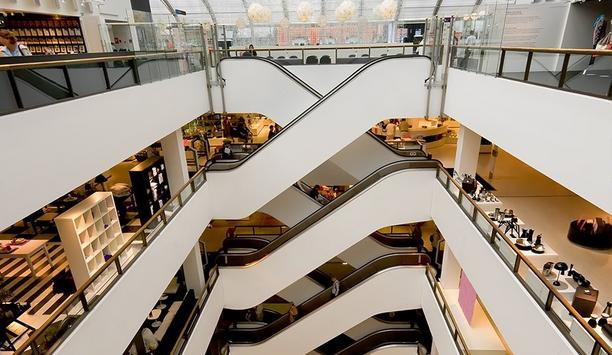
Delivering Smart, Secure and Healthy Retail Environments with the Cloud
Download
The Healthy Market For Video Surveillance At Medical Facilities
Download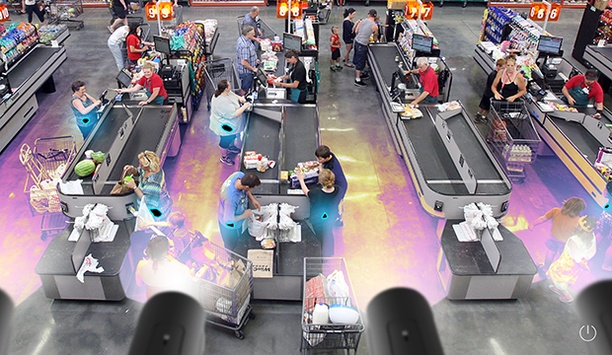
How To Catch Shoplifters With Thermal Imaging
Download

